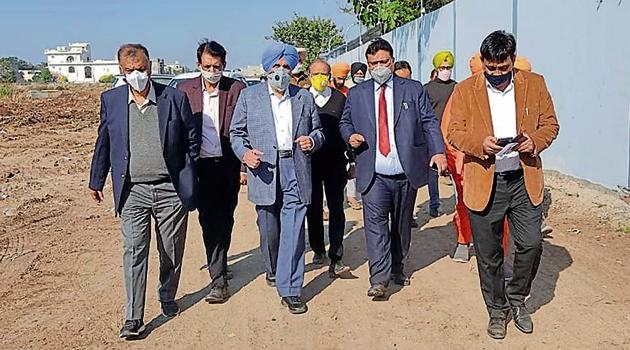Nothing concrete done to control Buddha Nullah pollution, finds NGT team
The committee, during its visit to the city on Friday, told MC that if it fails to stop the flow of sewer water into Buddha Nullah by March 2021, it may have to pay ₹10 lakh for each drain every month as penalty. At least 16 drains converge into the highly polluted Buddha Nullah from different parts of the city. In all, the MC may end up paying ₹3 crore a month, they warned.
Finding no progress in the upgrade of sewer treatment plants (STPs) that are meant to reduce pollution in the Buddha Nullah, the monitoring committee of National Green Tribunal (NGT) warned the Ludhiana municipal corporation (MC) of a higher penalty if corrective steps are not taken.

The committee, during its visit to the city on Friday, told MC that if it fails to stop the flow of sewer water into Buddha Nullah by March 2021, it may have to pay ₹10 lakh for each drain every month as penalty. At least 16 drains converge into the highly polluted Buddha Nullah from different parts of the city. In all, the MC may end up paying ₹3 crore a month, they warned.
The six-member NGT committee was led by chairman Justice Jasbir Singh (retd) and Justice Pritam Pal (retd). Former Punjab chief secretary SC Agrawal, former Haryana chief secretary Urvashi Gulati, environmentalist Sant Balbir Singh Seechewal, and technical expert Dr Babu Ram, who is also a former member secretary of Punjab Pollution Control Board, are part of the committee.
The committee members raised doubts over the working of the real-time monitoring system installed in Jainpur village to check the pollution in Buddha Nullah. Committee member Babu Ram said that against an suspected BOD (biochemical oxygen demand) of 250, the system showed a reading of 40. The committee collected samples from the site to cross check the facts.
Other projects inspected
The team inspected different ongoing projects, including the Common Effluent Treatment Plants (CETP) for dyeing industry on Bahadurke Road, carcass utilisation plant, modern slaughterhouse and micro-forests being set up on the banks of Buddha Nullah. They also directed the SPVs of the Focal Point and Tajpur Road dyeing cluster to commission their CETPs by December-end.
The committee praised MC chief Pardeep Sabharwal and the additional commissioner (income tax) Rohit Mehra for the 10 micro forests being set up on the banks of the Nullah. The authorities said they have planned 300 such forests for the city.
Committee chairman Justice Jasvir Singh (retd) said, “It is good that the MC is working on the construction of a carcass plant and slaughterhouse. However, nothing concrete has been done to reduce the pollution of Buddha Nullah. If the MC fails to stop flow of sewage from 16 points, it will have to pay ₹10 lakh a month for each drain, as the NGT’s past orders.”
‘₹15 crore wasted’
Justice Jasbir Singh further said that five green bridges were established with the help of central pollution control board (CPCB) at a cost of ₹15 crore for bioremediation of polluted water in the Nullah in the past. But the bridges are now lying defunct as the MC failed to maintain them.
‘Nullah cannot be covered’
Slamming the proposals being submitted by different industrial organisations, seeking the covering of the nullah for construction of buildings on the same, Justice Jabir Singh said, “Buddha Nullah cannot be covered and NGT will not allow the same. We should rather work to reduce pollution in the nullah.”
‘Establish carcass plant by Feb or face ₹1 lakh per month penalty’
Ludhiana: With the MC delaying the competition of carcass utilisation plant being established at the cost of ₹7.98 crore in Noorpur bet area, the monitoring committee directed it to complete the project by February 2021 or pay ₹1 lakh a month as penalty till the project is complete.
The project was to be complete by August this year but the deadline was extended to December due to the lockdown. The plant is being establish so that the ‘Hadda-Rodi’ being run on the banks of Sutlej can be closed. The skinners dump the waste in the river which adds to the pollution.





